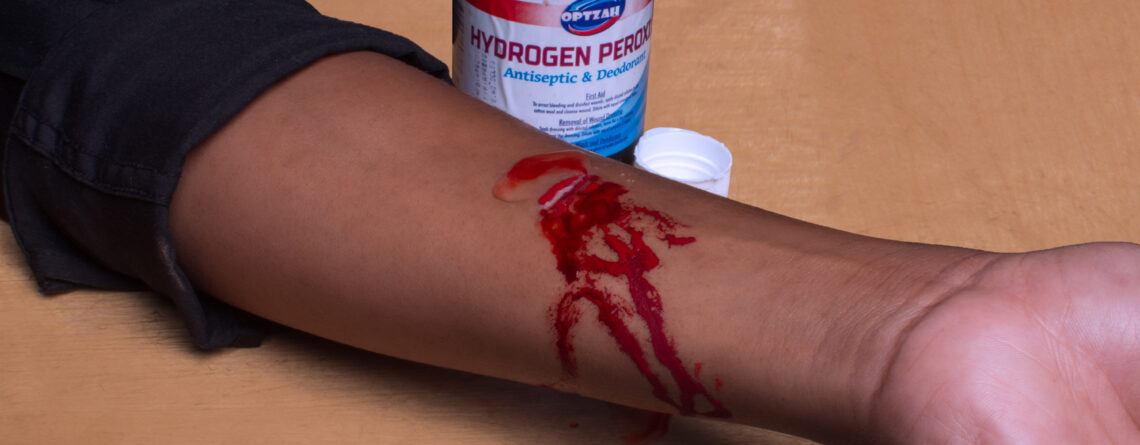Ways to use hydrogen peroxide
Ways to use hydrogen peroxide
Get ready for the wonderful world of H202—you can use hydrogen peroxide to:
Disinfect
Move your peroxide from the medicine cabinet to the cleaning cabinet. It’s a great alternative to bleach and won’t make your house smell like a swimming pool.
Use peroxide in a well-ventilated area and wear gloves. “There’s a chance of toxicity if you inhale it, and it can irritate the skin and eyes,” Dr. Beers says.
To disinfect, first clean any visible dirt or grime off the area with plain soap and water. Then spray surfaces with a 50/50 mix of peroxide and water. Let it sit for five minutes or longer. Rinse surfaces that touch food, like cutting boards, but let other surfaces air dry.
Hydrogen peroxide is a great germ-killer for:
- Bathtubs, sinks and showers.
- Counters.
- Cutting boards.
- Doorknobs.
- Garbage cans.
- Mirrors.
- Refrigerators.
- Toilets.
- Toys.
“Peroxide kills bacteria, fungi and viruses,” Dr. Beers explains. “It can come in handy if you don’t have disinfecting wipes or bleach. Just be careful not to get it on your clothes or furniture, or it may bleach them.”
Wash produce
Looking for a cheap and effective way to remove germs and pesticides from fruits and vegetables? Peroxide can do the job.
Fill a large bowl or clean sink with water and add one-fourth cup of peroxide. Wash produce in the water and peroxide mixture, rinse thoroughly with clean water and dry. Bonus: Cleaning your produce with peroxide could extend its shelf life.
Don’t try this cleaning method with household disinfecting sprays or wipes. They contain chemicals that aren’t safe to use on food.
Remove household stains
Peroxide has serious bleaching power, making it an effective stain remover. But don’t use it on colored items. And always test it in a hidden area first.
Here are a few ways peroxide gets rid of annoying spots and stains:
- Whitens carpet: If you have a white or off-white carpet, spray peroxide directly on carpet stains. Rub lightly with a clean cloth.
- Removes clothing stains: Soak white or off-white clothes in a bucket of water mixed with 1 cup of peroxide for 30 minutes. You can also add peroxide directly to the bleach compartment in your washing machine. Warning: Don’t try this on colored fabrics or vintage clothes!
- Brightens tile grout: Spray peroxide directly onto grout and let it sit for several minutes. Scrub with a stiff cleaning brush. Repeat if needed.
- Makes ceramic cookware gleam: Sprinkle pots and pans with baking soda and spray them with peroxide. Let them sit for 10 minutes, rinse and dry.
Clean beauty tools and nails
Peroxide isn’t a skin care product, but it is found in certain common items, such as whitening toothpaste or mouthwash. “Peroxide is also an ingredient in many tooth whiteners,” says Dr. Beers. However, talk to your dentist before using whitening products, since they can cause tooth sensitivity.
You can also use it to:
- Sanitize beauty and nail care tools: Use peroxide to clean nail clippers, tweezers and eyelash curlers.
- Fix stained nails: Did that trendy black nail polish leave unsightly stains on your nails? Pour a bowl of warm water, add 3 tablespoons of peroxide, and soak nails for three minutes.
- Make a mouthwash: Gargle with diluted peroxide to kill everyday germs in your mouth, or purchase mouthwash that contains peroxide (and probably tastes better). Don’t swallow it! Stop using it if you notice mouth irritation.
- Keep your toothbrush clean: Limited research supports this use, but you can clean your toothbrush by dipping it in peroxide for five minutes to kill germs and then rinsing thoroughly with water. If you choose this method, be sure to change out the peroxide daily—and be sure to replace your toothbrush at least every six months.
How to store hydrogen peroxide safely and properly
Hydrogen peroxide is a chemical. It can cause serious side effects if it’s ingested. Keep it in a locked cabinet out of reach of children and pets.
Before using peroxide, check the expiration date. “The extra oxygen breaks down over time,” Dr. Beers says. “Once it loses its bubbles, you’re basically left with water.” Keep peroxide in its original brown bottle or a dark spray bottle to avoid exposing it to light. If it’s not foaming anymore, dump it down the sink and buy a new bottle.
And rest easy knowing you’ll never again have to endure its sting on boo-boos.



LEAVE A COMMENT